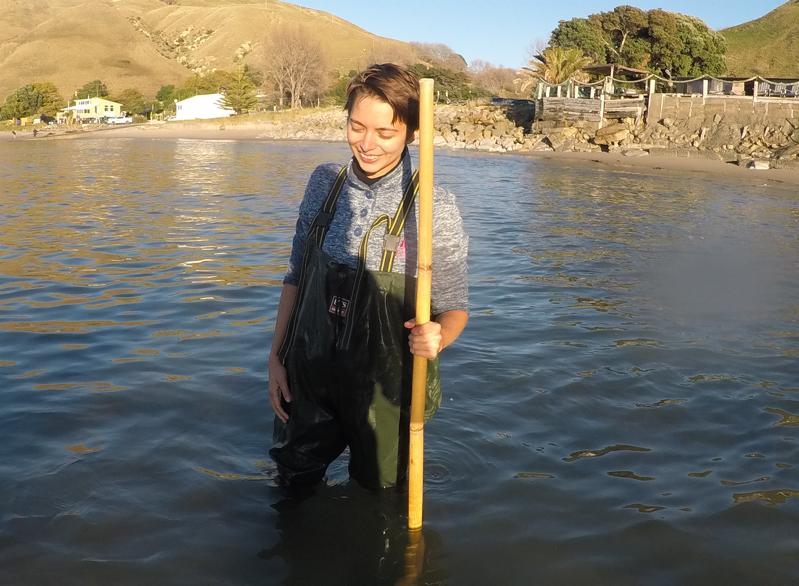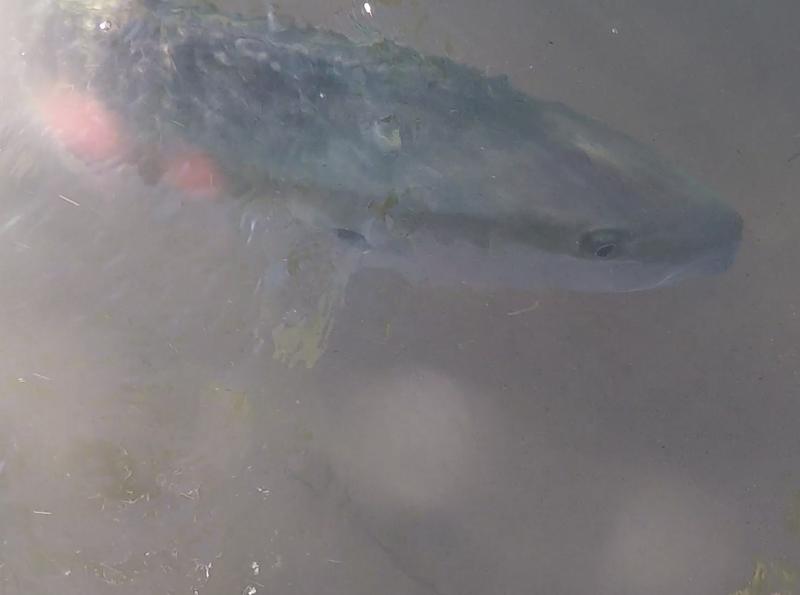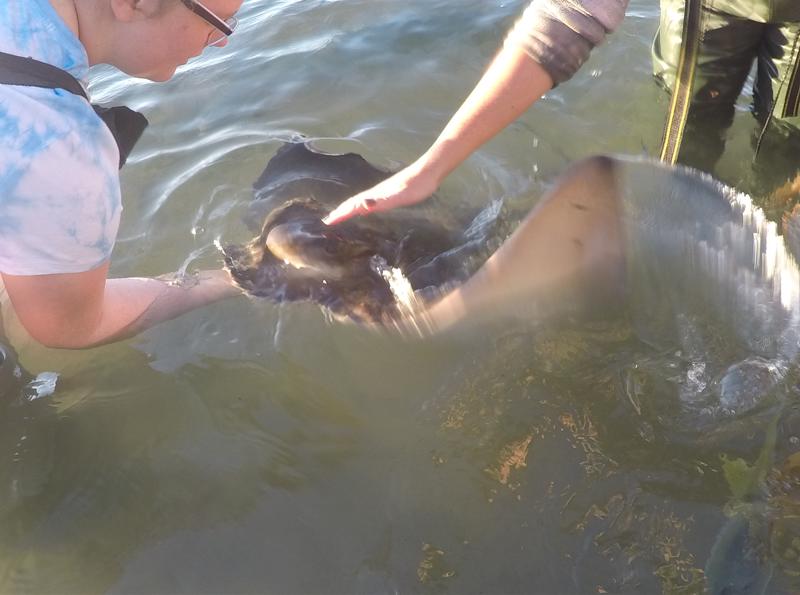(Barely) Working Title: How to retire in your twenties
The standard Saturday morning in Zealandia consists of rising before the sun to stroke some stingrays on the head, perhaps. After a short rest following our epic climb, we were feeling just supple enough to walk without wincing, so we made the short drive to Tatapouri to take a dip into the ocean shallows with our new flatmates (stingrays are flat. Get it?).
Our guide explained to us that we'd need to wear some very fetching waders for our sea-walk. We were also given some large bamboo sticks to aid stability whilst in the shallows as the tide is surprisingly strong. The overall effect is that the tour looks like a badly executed Gandalf-themed fancy dress party. The perfect attire greet some mystical creatures!
Entering the sea in a rather bizarre conga-line, we were almost immediately met with the intimidating sight of two yellow-tail kingfish. This large, subtropical species typically appears in depths of 40-150 feet but these particularly over-friendly characters have
Lewis George
81 hoofdstukken
16 Apr 2020
Stingray, Stingray!
Tatapouri
The standard Saturday morning in Zealandia consists of rising before the sun to stroke some stingrays on the head, perhaps. After a short rest following our epic climb, we were feeling just supple enough to walk without wincing, so we made the short drive to Tatapouri to take a dip into the ocean shallows with our new flatmates (stingrays are flat. Get it?).
Our guide explained to us that we'd need to wear some very fetching waders for our sea-walk. We were also given some large bamboo sticks to aid stability whilst in the shallows as the tide is surprisingly strong. The overall effect is that the tour looks like a badly executed Gandalf-themed fancy dress party. The perfect attire greet some mystical creatures!
Entering the sea in a rather bizarre conga-line, we were almost immediately met with the intimidating sight of two yellow-tail kingfish. This large, subtropical species typically appears in depths of 40-150 feet but these particularly over-friendly characters have

been following the stingrays into the shallows for food for a number of years. Kingfish can grow up to the size of a small adult human (50-60kg, or one Jane) and are extremely popular in fishing circles as a result of their gigantic size and gamey taste. Despite their apparent culinary popularity, these two showed no fear of humans and our guide warned us to keep our fingers tucked into a fist whilst in the water as kingfish are known to snack on human digits. The two we saw were (only!) 25-30kg, but they happily roughed up our rather unsteady group as we teetered in the shallows.
Soon after, the stingrays appeared. They glided over effortlessly - in stark contrast to the frantic kingfish. Watching their peaceful progress through the water, it's easy to see why the stingray holds such reverence in Māori folklore. Though naturally tranquil and curious beings, whai (stingray) are armed with a poisonous and potentially deadly barb, and are often depicted as Kaitiaki (guardians or protectors) by Māori.
In addition to their role as mythical guardians, stingrays are an important part in the creation story of Aoteoroa. It is said that Māui, the Polynesian demi-god, (as voiced by the Rock in Disney's feature film, 'Moana'), wanted to go fishing with his older brothers. The brothers refused to take him, such is the treatment of younger siblings. Not wanting to be left out of the fun, Māui stowed away in the family canoe, only revealing himself when far out at sea. The brothers were suitably annoyed and in a bizarre twist to this otherwise mundane family story, Māui preceded to fish using a magic hook, fashioned from the jaw bone of his dead grandmother... Classic younger sibling behavior!
Using this enchanted equipment, Māui hauled out the enormous fish that we now know as New Zealand's North Island.


In numerous versions of the story, the Te Ika-a-Māui (Māui's fish) is depicted as an Eagle-ray, and we can roughly make out the whai's shape in the modern-day map if we imagine the stingray is swimming downwards. The head lies at the south of the North Island (around Wellington) and the tail is the Northland region. The fins are Taranaki and the East Cape, and the Coromandel Peninsula is known as 'Te Tara o te Whai’, or 'the barb of the stingray'. Speaking of stingray barbs - by this point on the tour my internal monologue was entirely dedicated to repetition of the phrase "Don't mention Steve Irwin. Don't mention Steve Irwin."
Within seconds, someone had mentioned Steve Irwin. It wasn't me. Our guide explained that we needn't worry about these particular stingrays as they're essentially domesticated. Local humans have built relationships with them over a number of years, there is a mutual trust and they are unlikely to sting unless aggressively provoked. That helped to allay our fears. The comment "An eagle-ray's barb can cut through bone" had the opposite effect.
It's incredible how intelligent these elegant creatures are. They have electro-sensory organs that can detect a heartbeat. This highly sensitive software is primarily used for detecting prey hidden in the sand but we're told it also plays a part in their appearance in the tour as they can sense the presence of a number of human pulses. We

were amazed at how sentient these fish are - rays can even use their superpower to distinguish individual humans by their tone and rhythm, happily greeting individuals who they know whilst approaching those they don't with extreme caution.
With some encouragement from our guide, we each had the opportunity to stroke the stingrays - moving your hand towards them in a fist is essential otherwise the kingfish will strike. Then, with a flat hand, you can pet the stingray, avoiding the barb at the base of the tail (the Coromandel Peninsula when looking at a map). One of the reasons they like human contact is because a gentle pat helps to remove sand and dirt from the back of the ray. Apparently this feels nice for them. For the human, it feels rather like stroking a sandy wetsuit. We fed the stingray some barracuda meat whilst our guide explained to us that she is the oldest tour guide they have, at the ripe old age of 18. What a first job that would be! Slightly more interesting than my months spent working in a Little Chef...

1.
The first trip: Miranda to Thames
2.
Land of the Long, White Cloud
3.
Backyard Exploring
4.
Hit the Road, Jack
5.
Under the Weather
6.
The Road of Death?
7.
An Eel called "Eel"
8.
Descent into the Black Abyss...
9.
Everybody's Going Surfing...
10.
Living in a van: is this the real life?
11.
Out with the Old and in with the New (Plymouth)
12.
Walk this Way
13.
The Great Taranaki
14.
The "Forgotten" Highway
15.
Chronicle + Art = Article
16.
Derby Day
17.
Mission Accomplished: Come on you Nix!
18.
The post-Phoenix hangover
19.
The Tongariro Alpine Crossing
20.
Whanganui 2 - This Time it’s Personal
21.
Tui-many puns and Hastings
22.
The Giant Among Us & Bell Rock
23.
Acoustics, Art & A Bloody Cold Sea
24.
Napier Calling
25.
Bridget Jones' Diary - Cheese, Chocolate, Wine
26.
Land and Sea
27.
Mahia-hee, Mahia-hu...
28.
The Gisborne Identity
29.
East Cape Escape
30.
The Long and Winding Road
31.
More or Less Pork.
32.
The Land of the Rising Sun
33.
Hikurangi: Reaching New Heights
34.
Stingray, Stingray!
35.
Bay of Plenty (of Surprises)
36.
Future Reflections
37.
Birthday Part 1 - Going Off Pissed
38.
Birthday Part 2 - Going En Piste
39.
Mid-Winter Christmas
40.
I Get Knocked Down (But I Get Up Again)
41.
Job Hunting: I Need a Dollar, Dollar
42.
Busy Earnin'
43.
Hoppy Daze
44.
Making a House a Home
45.
What to expect when you’re expecting
46.
Bright Lights, Big City
47.
Feeling Each and Every Mile
48.
What to export when you're exporting
49.
Waipapa Marae: An Unexpected Welcome
50.
Tane of the Sky Father
51.
The Boy Most Likely To
52.
Go Rooster!
53.
Friday 13th
54.
Mild Orange, Heavy Chest
55.
Champions of the World
56.
Wild, Wild West (Auckland)
57.
Team Zlatan Heineken
58.
Great Expectations
59.
Un petit rendezvous
60.
Duck Island (sans canards)
61.
It’s Coming Home?
62.
Culture, init?
63.
Sue’s Turtle Garden
64.
New Caledonia - It’s a Rollercoaster (metaphorically)
65.
It’s gone abroad...
66.
Future Me Hates Me
67.
“You can’t beat Wellington on a sunny day”
68.
Te Papa Tongarewa: New Zealand’s Treasure Chest
69.
Island in the Sun
70.
Wine on Waiheke
71.
I'm Dreaming of a Really Sunny and Warm as Hell Christmas
72.
A Visitor!
73.
New Year, New Zealand
74.
Worm-tomo
75.
A Vicious Cycle
76.
Tongario 2.0: This time it's actually visible
77.
Wow Nature, you furry
78.
Whakarewarewa: Living Māori Vilage
79.
Ain't No Mountain...
80.
Hot Rodders & Hotter Weather
81.
North Shore, Not Sure